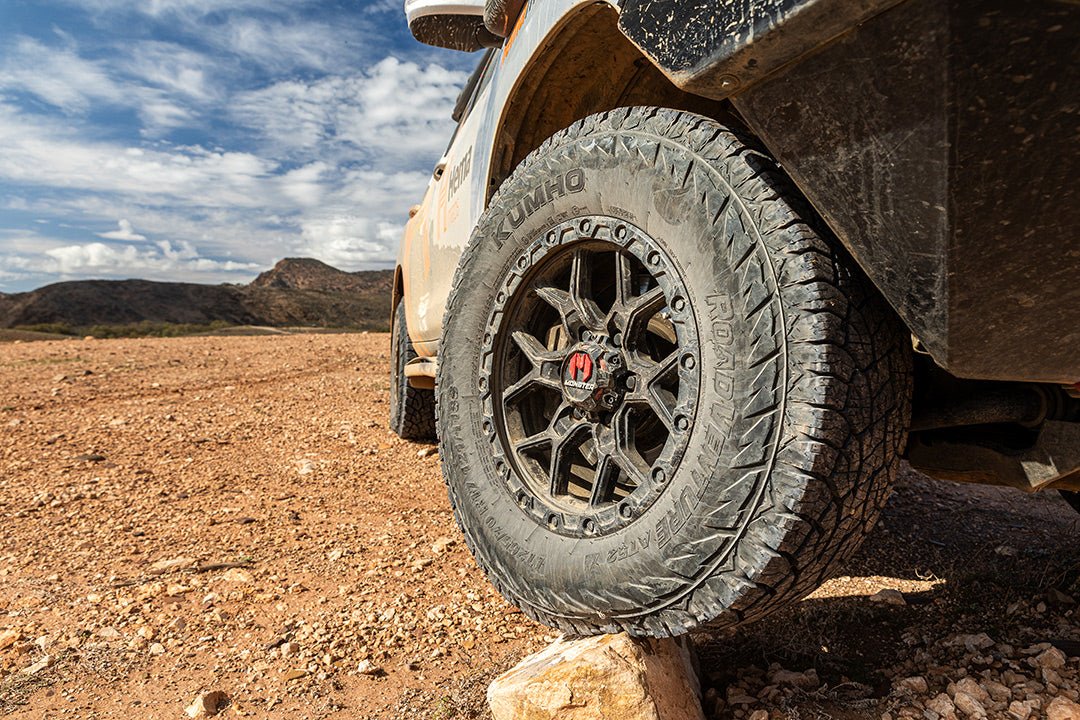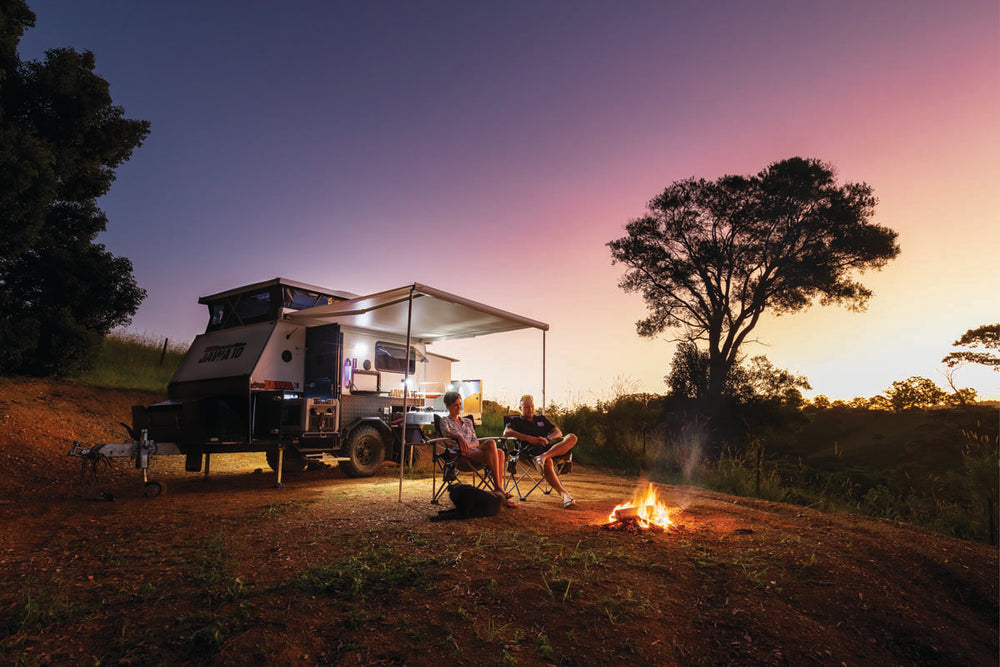

Bigger tyres look tough, but do they help towing? We ask an expert about the pros, cons and legalities of upsizing your wheels for offroad and touring.
Four-wheel drive manufacturers usually select OEM tyres and rims based on cost and around-town, on-road performance. There are a variety of reasons why caravan owners may wish to change the tyres and rims on their tow rigs. Let’s say it upfront, aesthetics plays a big part. Chunkier tyres just look tougher and swapping out rims is a popular way to personalise a rig. But there are a bunch of functional reasons to consider changing tyres and even rims. A big part of the decision when changing wheels is “Should I go bigger and if so, how much?”
We enlisted the help of John Kulikowski, wheel and tyre guru, from Bob Jane T-Marts to answer a bunch of questions for us.
JH — What are some functional reasons for changing tyres?
JK — There are a lot of good reasons to change tyres. I think the top reason is standard road tyres simply aren’t as strong as light truck construction (LT) tyres. Any reputable all-terrain or mud tyre (we’ll call them collectively offroad tyres for simplicity) will have an LT rated version with a heavier-duty construction. This makes offroad tyres much more puncture-resistant and have higher load ratings. Attaching a caravan onto the back of your car adds hundreds of kilos pushing down on the rear tyres, making an LT tyre a better choice. Upgrading to larger offroad tyres can also be a legal requirement if the vehicle has had a GVM upgrade — a modification to a vehicle to enable it to carry higher loads legally.
(Check out this feature to find out more.)
Offroad tyres have stronger side walls which means the tyre can cope with running at reduced pressures in offroad applications. Obviously, offroad tyres have more aggressive tread patterns that give them better traction off the bitumen, but worse on the bitumen. Mud tyres generally win out for pure offroad applications, but all-terrain tyres are often the best compromise for people touring/towing or just want a stronger tyre for day-to-day use.


JH — Why would you change rims?
JK — A GVM upgrade may require rims to be changed over to ones with higher load ratings just like we already mentioned with tyres. Also, modern 4WDs often have large-diameter rims with low-profile tyres. While the overall wheel size is big, this is not ideal for offroad applications for a couple of reasons. A low-profile tyre doesn’t provide much buffer between the ground and the rim. If you hit a rock or similar a bit too hard it is more likely to damage the rim. One of the reasons we reduce tyre pressures offroad is to increase the tyre contact patch with the ground for increased traction. A low-profile tyre has very limited ability to increase its contact patch when running lower pressures. A solution is to switch to a smaller diameter rim to enable a higher profile tyre to be fitted.
JH — What are the pros of larger-diameter tyres?
JK — The bigger you go the easier it is to roll over obstacles. Think about how a little stone can stop a skateboard wheel but a big mountain bike wheel can roll over a gutter. A taller tyre also lifts your chassis higher which improves the ground clearance of your differential and so on. A suspension lift does not achieve this as it only lifts the body higher relative to the chassis. We already mentioned a larger diameter/higher profile provides more buffer between the rim and ground — this also helps to provide some extra ‘suspension’ for a more comfortable ride. It’s also worth pointing out that a taller tyre profile rather than tyre width gives you an increased contact patch with the ground when you lower tyre pressures. This is because the tyre/ground contact patch gets longer when it is deflated but doesn’t get much wider.

JH — What are the cons of larger-diameter tyres?
JK — Here’s a little bit of maths and physics. A larger diameter means you also have a larger radius (distance from the centre of the hub to the outside edge of the tyre) and a larger circumference (length of the tyre if you could roll it out flat). A larger radius is the same as a longer lever. It takes more energy to make the longer lever begin to turn. This means you burn more fuel with taller wheels, and it may feel like the car lacks power. A lack of power will be more noticeable when towing. It is also harder to get the larger wheel to stop once it gets going which increases braking distances. Again, towing can contribute to greater stopping distances, so taller wheels on the tow vehicle will compound this. In extreme offroad conditions, this extra leverage can put more stress on the drive train causing components to fail. An example is if a wheel lifts in the air and is spinning fast and it comes to an abrupt stop when it comes back down on the ground, the extra leverage has an increased chance of breaking a CV or other driveline components.


A larger circumference means for one revolution of the wheel, the car travels further. In other words, the car now has a higher gear ratio, which has a few knock-on effects. You will be travelling faster than your speedo shows because it works on rotation sensors in the transmission calibrated to the standard wheel diameter. Taller gearing will mean you are travelling faster when you are relying on locking into a lower gear and engine breaking down a steep hill. Your car may struggle to hold top gear at cruising speed as it is now too high for the engine to power it at a comfortable RPM. This can be more evident under heavy loads such as towing.
We already mentioned that a taller tyre raises the body of the car, which is good for ground clearance, but it also raises the centre of gravity of the car. This makes the car less laterally stable increasing body roll and susceptibility to the van pushing the car around. In extreme cases, it can increase the chances of the car possibly rolling.
A larger diameter tyre, particularly if it is an offroad oriented tyre, will be heavier than a smaller tyre. This increases rotational mass which also has the same result of taking more energy to start and stop the wheels turning. Finally, a heavier wheel contributes to a higher unsprung weight which makes it harder for your suspension to react to bumps in the road which can contribute to a less comfortable ride. (It’s also worth pointing out even if you stick with the standard-size tyre but switch from a standard road tyre to an offroad tyre, it is likely to be heavier which will impact rotational and unsprung mass.)

JH — What are the pros of wider tyres?
JK — Wider tyres give you more contact patch on the ground for increased traction on and off the road. But as we touched on before most of the gains from decreasing tyre pressures for offroad applications come from having a larger diameter tyre rather than a wider tyre. They also increase the distance from the outside edge to outside edge of the tyre which improves stability in lateral rolling which can provide better and safer handling on and offroad.
JH — What are the cons of wider tyres?
JK — Wider tyres have greater rolling resistance offroad because they need to push more dirt/sand/mud out of the way while rolling along. They are also heavier than a standard-width tyre so again it will impact on rotational mass and unsprung mass as we mentioned earlier. Wider tyres protrude out further from the hubs which can firstly put more stress on parts of the wheel bearings and secondly cause the tyres to poke out from the body, which becomes a legality issue according to Australian regulations.
JH — How big is too big?
JK — I have covered a lot of stuff here that makes it sound like taller or wider tyres are scary and unsafe. The reality is many people increase tyre sizes slightly and it improves their offroad experience and does not unduly compromise towing. Because there are so many variables, I can’t give you a one-size-fits-all answer to how big is too big. Fortunately, our Bob Jane T-Marts stores have a wealth of practical experience fitting larger tyres to cars. They can work through important things like choosing tyre sizes to avoid them rubbing on parts of the car or poke outside the wheel guards.
Also, very importantly, there are laws relating to maximum wheel diameters and widths.

JH — What are the legalities of upgrading to bigger tyres?
JK — This is a bit messy because there is a national regulation but then there are state regulations that sit on top of that, and the regulations vary from state to state. In general, it is possible to increase both the diameter and width of tyres by a limited amount without having the vehicle certified by an engineer. On 4WDs, tyre diameters can be increased up to 50mm and tyre widths can be increased up to 50 per cent without the need for engineering certification. There are other variables that can come into play. Different states have different limits on the overall height a 4WD can be increased by whatever means — suspension lift/body lift/taller tyres. So, for example, if a state has a limit of an overall lift of 50mm and you already have a 50mm suspension lift you can’t run taller tyres. Also, the wheel track comes into play. To prevent taller or wider tyres rubbing on the car it may be necessary to change to rims that stick out further (negative offset). Changing the offset changes the wheel track and there are limits on how much you can change the wheel track so this could be your constraint in changing tyre size.
You see a lot of 4WDs today with wheels and tyres extending beyond the body of the car due to the incorrect offset wheel being put on the vehicle. This is a legal requirement that is often overlooked by most owners and retailers.

Final advice on upgrading to bigger wheels
When you start asking questions you realise there is a lot to understand when considering bigger wheels. It can seem all a bit too hard, but the reality is many people enjoy the benefits of upsizing. The trick is to be smart about it and use the expertise of reputable retailers such as Bob Jane T-Marts.
Learn more on the Bob Jane T-Marts website or give the team a call on 132 625.
THE NEXT STEP
If you want to learn the latest caravan news, find the most innovative new caravans and camping gear or get inspired to plan your next adventure on the open road, subscribe to our weekly newsletter. We promise to send you only the best content.







